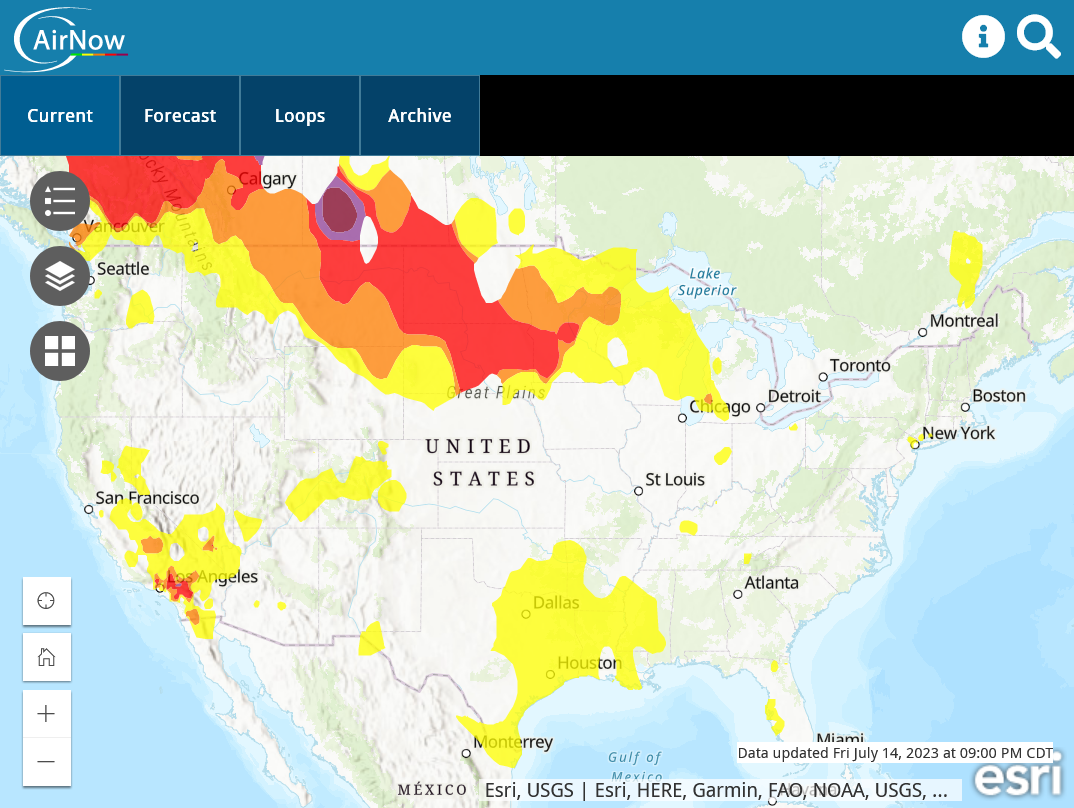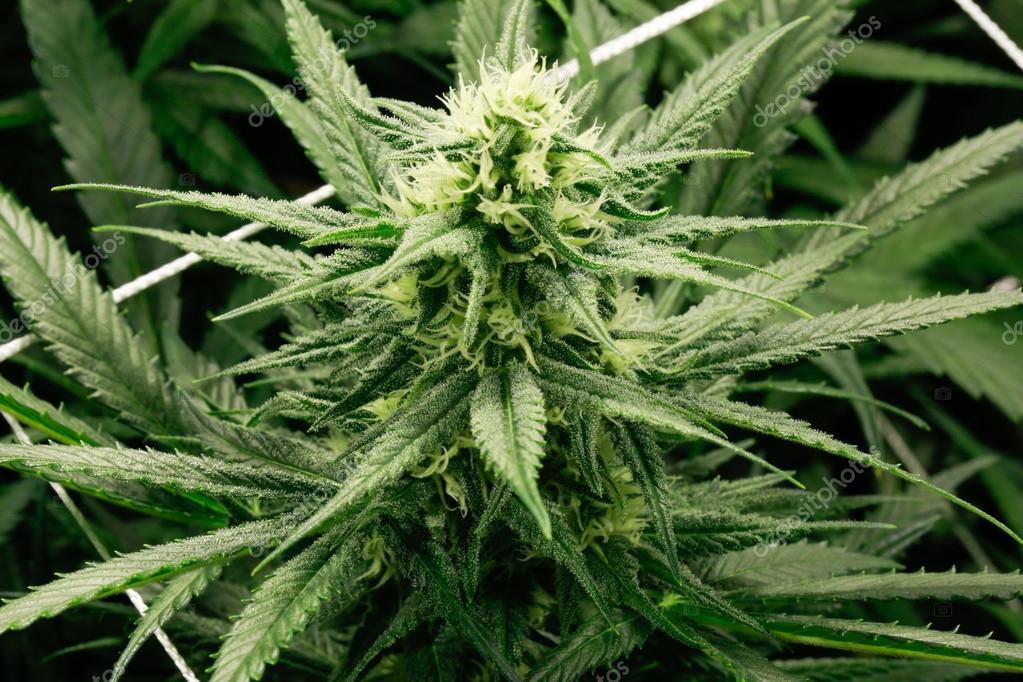
Previous threads:
Air quality/Wildfires in E.Canada 6-28-23
Started by metmike - June 28, 2023, 1:29 p.m.
https://www.marketforum.com/forum/topic/96802/
Wildfires in Canada
29 responses |
Started by metmike - May 19, 2023, 4:53 p.m.
https://www.marketforum.com/forum/topic/95312/
Here are the latest conditions:

https://map.purpleair.com/1/mAQI/a10/p604800/cC0#3.4/38.05/-87.53

Much of the gray shade is from wildfire smoke

https://cwfis.cfs.nrcan.gc.ca/maps/fw?type=fwi
Keep in mind that these smoke model forecasts exhibit less skill with time. Wind direction, number of fires burning and rain can have an impact.
https://weather.gc.ca/firework/firework_anim_e.html?type=em&utc=12
This is towards the end of the 72 hour loop, from this mornings forecast for Sunday at Noon CDT.

Mike, I just commented to our son that the corn looks exceptionally green and the bottom leaves don’t seem to be turning off like they normally do when the plant is at maximum height. I am seeing the same in our alfalfa crop, green leaves all the way down and it is unusually thick. Our garden plants are much larger than normal, now we don’t always plant the same varieties so a direct comparison can’t be made, but everything has much more foliage and has better color. The green beans have been some of our best. The sweet corn I can hardly walk through, the lower foliage is still vigorous and green.
His reply:
“ There is new research showing smoke increases photosynthesis by keeping solar radiation below the turn off threshold.”
While looking for popular culture articles to support this I ran across this article:
https://eos.org/research-spotlights/wildfire-smoke-boosts-photosynthetic-efficiency
(summary)
”The researchers’ measurements showed that the total amount of sunlight available to plants for photosynthesis decreased only slightly—by about 4%—compared to the previous summer. In other words, the smoke didn’t block the light; it scattered it, increasing the amount of diffuse light by about a third. Whereas direct sunlight might fall mainly on upper foliage, leaving the rest of a plant in shade, diffuse light can reach a greater number of photosynthesizing leaves throughout the vegetation canopy. Because of the haze, plants used the available light nearly twice as efficiently, the team reported.”
So, possibly two effects happening. One, the plant is getting light but it is diffuse and not tripping the plant’s “overload” mechanism; and two, the diffuse light is coming from directions that allow it to penetrate deeper into the canopy.
We here in NW Iowa have been hand to mouth for moisture, but being in the prairie pothole region that is our best scenario. If things continue as they have been we will be looking at a third record yield in a row. I can remember only one year when the corn was more advanced on July 4.
You heard it here first.
Mike, have you seen anything that would support the above ?
Welcome back mcfarmer!
It's hard to describe the profound value of your wonderful post to me, personally as a scientist.
It's like an Issac Newton watching the apple falling and discovering gravity moment.
This will sound nuts to everybody else but I will remember this morning for the rest of my life and can't thank you enough for sharing this incredible discovery here with us.
I remember reading an article or 2 about the smoke scattering light and causing it to be more diffuse before but brushed over it at those times.
Congratulations, mcfarmer you and your farm/garden have been part of a scientific experiment helping to confirm a process that almost nobody knows about regarding the impact of downstream wildfire smoke!
"You heard it here first"
That was an understatement!
It's worthy of recognition that places it above all other posts. It will actually take me awhile to wrap my head around what it might mean for crop yields this Summer.
Up to an hour ago, I would have been confident that it wouldn't make much difference based on what I thought that I knew. If anything, REDUCE crop yields because of blocking the vertical sunshine From above.
However, that is no longer true because:
1. I know you as a credible source when it comes to science and observations from past posts.
2. I checked quickly for confirmation with scientific studies.........BINGO! The science backs your observations up, mcfarmer. That, despite the speculative narratives that are still out there by scientists that wildlfire smoke from climate change reduces crop yields.
The actual measured observations
Enhanced Photosynthesis and Transpiration in an Old Growth
Forest Due To Wildfire Smoke
https://www.fs.usda.gov/pnw/pubs/journals/pnw_2022_rastogi001.pdf
Just this week
Is Wildfire Smoke Affecting Midwest Crops?
https://www.croplife.com/crop-inputs/is-wildfire-smoke-affecting-midwest-crops/
“Based on what is known about the effects of reduced solar radiation, it seems very plausible that wildfire smoke (from climate change) could cause reductions in crop yields,” said Ben Jacob, Pioneer Field Agronomist.
mcfarmer,,
Consider yourself SMARTER than Ben the Pioneer Field Agronomist, at least about this topic!
How to recognize your post here?
Discovering something with such significance and that most of science still doesn't know, means that post of the week doesn't do it justice.
Humans have been around for a long time(over a million years if including our ancestors) and most of them, including experts in this field, agronomists still don't know about your scientific discovery.
https://www.history.com/news/humans-evolution-neanderthals-denisovans
One of the earliest known humans is Homo habilis, or “handy man,” who lived about 2.4 million to 1.4 million years ago in Eastern and Southern Africa
https://en.wikipedia.org/wiki/Geologic_time_scale
Formal, hierarchical units of the geologic time scale (largest to smallest)
| Chronostratigraphic unit (strata) | Geochronologic unit (time) | Time span[note 2] |
|---|---|---|
| Eonothem | Eon | Several hundred million years to two billion years |
| Erathem | Era | Tens to hundreds of millions of years |
| System | Period | Millions of years to tens of millions of years |
| Series | Epoch | Hundreds of thousands of years to tens of millions of years |
| Subseries | Subepoch | Thousands of years to millions of years |
| Stage | Age | Thousands of years to millions of years |
++++++++++++++++++++++++++++
Let's call your post our "POST OF THE EPOCH"
https://www.frontiersin.org/articles/10.3389/fpls.2015.00704/full
Plants use diffuse light more efficiently than direct light, which is well established due to diffuse light penetrates deeper into the canopy and photosynthetic rate of a single leaf shows a non-linear response to the light flux density. Diffuse light also results in a more even horizontal and temporal light distribution in the canopy, which plays substantial role for crop photosynthesis enhancement as well as production improvement. Here we show some of the recent findings about the effect of diffuse light on light distribution over the canopy and its direct and indirect effects on crop photosynthesis and plant growth, and suggest some perspectives for further research which could strengthen the scientific understanding of diffuse light modulate plant processes and its application in horticultural production
++++++++++++++++
Very much related to this which makes a connection:
I used to be a huge gardener for 2 decades. I grew almost every vegetable and plant out there just to grow it.
My youngest son liked to smoke weed in high school-graduated in 2009 and I confiscated his stuff one time after busting him, since it was illegal back then.
In 2010, my garden was being obliterated by excessive rains and I was bummed on July 4th and suddenly, came up with the idea of taking some of the marijuana seeds from one of his bags to try to grow it.
I used wet paper towels and 25 seeds. After several days, I got only 4 seeds to germinate, which was plenty for me because I planned to put them in pots, so I could move them around. I stopped gardening in 2012, partly because our backyard is surrounded by trees which were blocking all the sun, except between 11am-4pm.
I had 4 different places around our house that got optimal sunshine at different times of day that I planned to move the plants to every day, every day(this is insane but I did this for 3 months). My wife had this giant, 5 foot by 3 foot mirror that I also moved to those locations and propped up on the back side of the plants so the angle caused the suns rays to reflect onto the backside of the plants horizontally. I also had a fan on high speed blowing on the plants every night in order to try to strengthen the stems(thats how plants/trees respond to wind) and help lessen fungus/disease risk.
Within 3 weeks, 3 of the plants died and I wondered if it was from something that I did. Also, only the male plants flower and bud and produce. I had no clue what I had, so there was a 50-50 chance it wouldn't amount to anything except a plant but I never wavered with the strategy with my 1 last plant. Turns out to be a good thing because adjusting the mirror with 4 plants would have been less effectively. I would often go out there every hour to adjust the mirror, as the sun moved. Seriously, I did this from late July into October on most days. I'm convinced that huge mirror, reflecting the intense sun, horizontally on the back, normally shaded side from the ground up had a huge impact.
I also had a big garden in the backyard and compared to working in the garden, the labor was easy......it just required constant adjustments. I traded for a living from home, so I was here every day to do it. I coach chess Nov-April at 5 schools, so no conflict there.
I called Vectren every month(Aug-Sep-Oct) to find out when the meter reader was coming. On those days, I would not have the plant in a place where they would see it in fear that it might get reported.
I contemplated spending several hundred bucks on growing lights to grow it safely in the basement with no need to constantly move it around and then still have the growing lights to grow other stuff.
I never grew a plant like this and didn't have anything to compare it to. It wasn't growing especially tall, only around 2.5 feet but had tons of dense, very green leaves, robust stalk and stems. I also had no clue on whether it was a male which was needed. I used amended top soil from the Wabash River bottom, with some sphagnum peat moss to hold more moisture and sand to drain well, along with Miracle Grow for extra nutrients and a touch of lime to raise the PH. It was heaven for any plant!
These plants are like soybeans and the shorter days trigger the flowering period. I started this plant in early July and knew this really shortened the vegetative growing period before the shorter days MIGHT trigger flowering and thought it might really limit its potential, even if it did end up flowering.
Short-day & Long-day Plants: Photoperiodism
What is photoperiodism?
https://myperfectplants.com/blogs/blog/short-day-long-day-plants-photoperiodism
So many unknowns the first 2 months but this plant was pampered every single day with constant attention...........and the key bonus that my weed plant was getting that no other plants were getting anywhere that I know about that Summer was a huge mirror on the back side that was reflecting the sun horizontally from the ground up to the normally shaded leaves.
Then, in early September.............IT FLOWERED! These were not any flowers that I'd seen before, so at first I wasn't sure thats what was going on.

At that point, I realized it would produce "something" and my hard work had more than paid off. I don't smoke weed and had 0 intention of using it for me or anything other than a home agronomy/plant science experiment.
There were many dozens of flowers that turned to buds which densely covered the small plant. I wondered if there would be enough warmth/sun left in the growing season to allow the buds to mature? These are tropical plants and October weather in IN can get pretty chilly and cool temps would certainly slow the buds from maturing.
In moving the plant, after the buds were fattening up I noticed an extremely strong, very distinctive aroma associated with marijuana plants.
Both my sons discovered the plant in September and they were shocked. My wife too and she was mad at me because she thought I was growing it to use for personal weed smoking. This was over a decade ago and in Indiana.
I finally brought the plant into the house in late in October, before a big cold wave and hung it upside down from the ceiling in our furnace room to dry for a couple of months. To be honest, I probably violated a few principles of people that grow week for a living but the extra sun from the giant mirror added massive yield that exceeded my mistakes.
I had enough buds to fill 4 jars with over 100 buds. I gave away 3 jars and forgot about it until now. I just checked, there's still a jar of buds left, 13 years later!
My wife got a new job 7 years ago and her boss smoked weed, so I gave him several buds. After he tried it, he gave the rest back, insisting that it was laced with some sort of potent chemical because it caused him to have scary hallucinations and a panic attack.
I've still not tried it myself but am tempted now to complete the experiment (-:

The experiment showed how placing mirrors with the right design on the floors of a multistorey farm can increase the amount of valuable and free sunlight for growing plants. As can be seen from the numbers in Table 2, Table 3, and the line graph 1, the combination of mirrors significantly illuminated the depth of the floor. While the mirrorless floor is deprived of adequate light in two-thirds of its depth, and the last third of the depth of the floor receives very little light, which is the result of light scattering from the walls of the model. In fact, this diffusion of light by the walls should not be considered because a real vertical farm is empty of walls in its depth, and irregular reflection will not be seen in it.
https://pllight.com/grow-light-reflector/
Reflector patterns, materials and shapes really affect the dispersion of light and how it is distributed out of the grow light reflector. Basic Physics….Flat surfaces do not reflect as efficiently as a curved surface in a reflector. White is a reflective medium, but it is not as reflective as a shiny aluminum type surface. A dimpled texture vs. a smooth surface will also diffuse the light and provide more coverage. So, when you are looking at a grow light reflector, ensure that you are getting maximum reflectivity from a shiny, curved and dimple textured surface . PL’s grow light reflector has a highly reflective finish which provides diffusion.
https://growace.com/blogs/learning-center/your-guide-to-reflectors-which-is-best-for-your-grow-room
Alright, let's talk grow light reflectors. If you ask 100 growers what their favorite reflector is you'll get 100 different answers. Some growers love wings because they're cheap, others like the focus cool hoods give you, some growers love umbrellas, and so on and so on...No two reflectors are made the same, so we're here to help you figure out what's best for you. Here we'll discuss what makes the most popular grow light some grower's favorite (and some growers' worst nightmare): umbrellas, wings, hoods, and air-cooled reflectors.
This is another example of how they will cherry pick data to mislead us into thinking there's a climate crisis.
Only using wildfire data starting in 1980........because if hides the fact that wildfires burned more than double the current acreage in the US a century ago. When there was much more drought in the US too. And only 10% of the CO2 emissions.
Challenging "Net Zero" with Science Richard Lindzen William Happer CO Coalition2.
